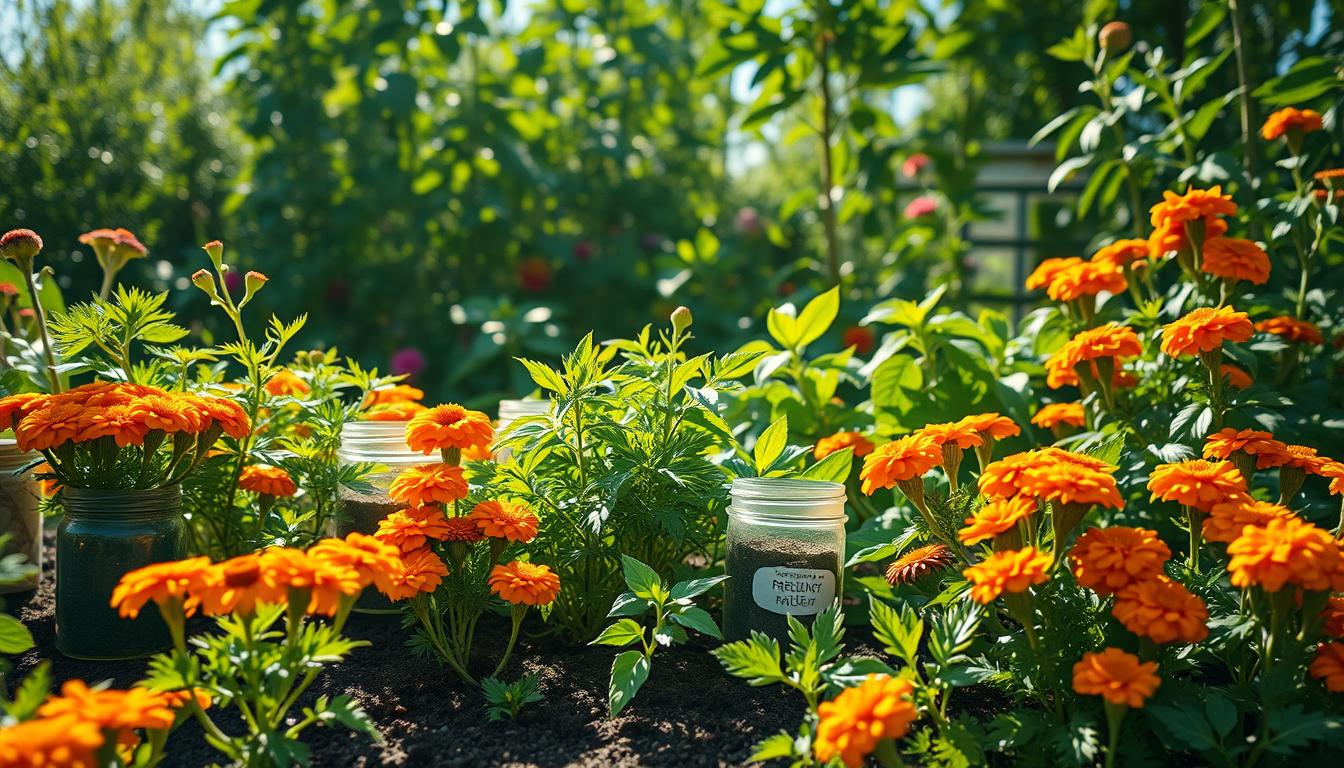As a gardener, I know how vital it is to keep insects away from my plants. To do this, I use effective methods to control pests. I’ve found that natural repellents are a great choice for a healthy garden.
In this article, I’ll share my easy and effective ways to keep insects off your plants. We’ll cover everything from why pest control is important to using physical barriers. My aim is to give you a complete guide to protect your plants. This way, you can enjoy a lush and thriving garden with natural repellents and pest control.
Understanding the Importance of Pest Control
Pest control is key for a healthy garden. Insects can harm plants, causing them to grow less, yield less, and even die. As a gardener, I’ve learned to protect my plants from insects. I use organic methods to stop infestations.
Knowing which insects harm plants is crucial. Watch out for aphids, whiteflies, and spider mites. These bugs spread disease and damage plants. It’s important to control them to keep plants healthy.
Why Protecting Plants Matters
Keeping plants safe from insects is vital for a healthy garden. Organic pest control reduces infestations and promotes plant health. It also keeps the garden’s ecosystem balanced, which is good for the garden’s long-term health.
Common Plant Bugs to Watch For
- Aphids: These small, soft-bodied insects can spread disease and damage plants.
- Whiteflies: These tiny insects can transmit disease and cause damage to plants.
- Spider mites: These small, spider-like insects can cause damage to plants and spread disease.
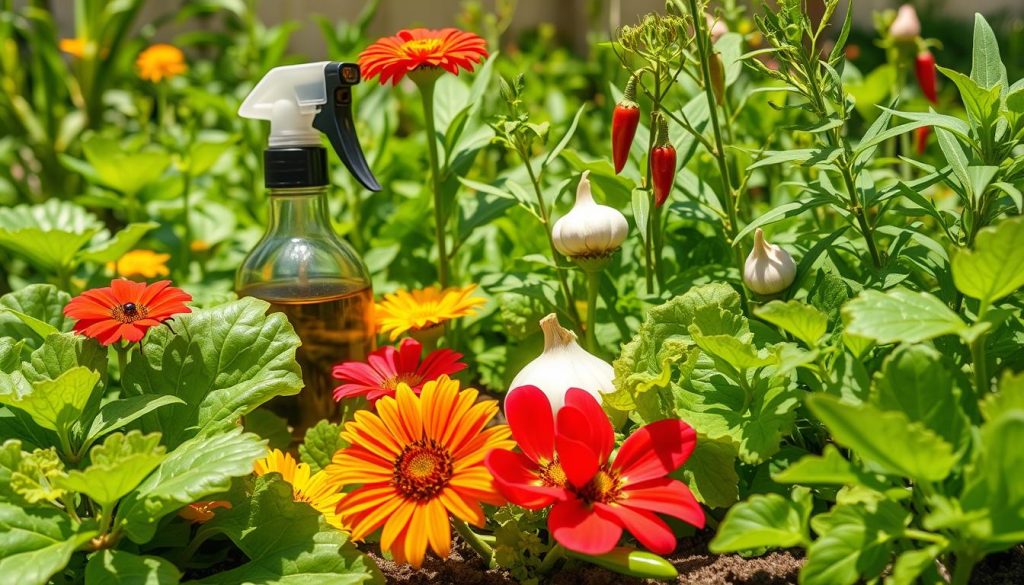
Understanding pest control and using effective methods helps gardeners protect their plants. This promotes healthy growth. Next, we’ll look at controlling insect infestations in plants and the benefits of organic pest control.
Choosing the Right Pest Control Methods
Protecting my plants from insects is a top priority. I look at different methods to find the best and most eco-friendly way. Keeping bugs out of my garden is key to a healthy ecosystem. Here, I’ll talk about the good and bad of various pest control methods, including organic and chemical ones.
Using plants that resist insects is a smart choice. It cuts down on the need for harmful pesticides. Eco-friendly ways to control insects are also important to protect our environment.
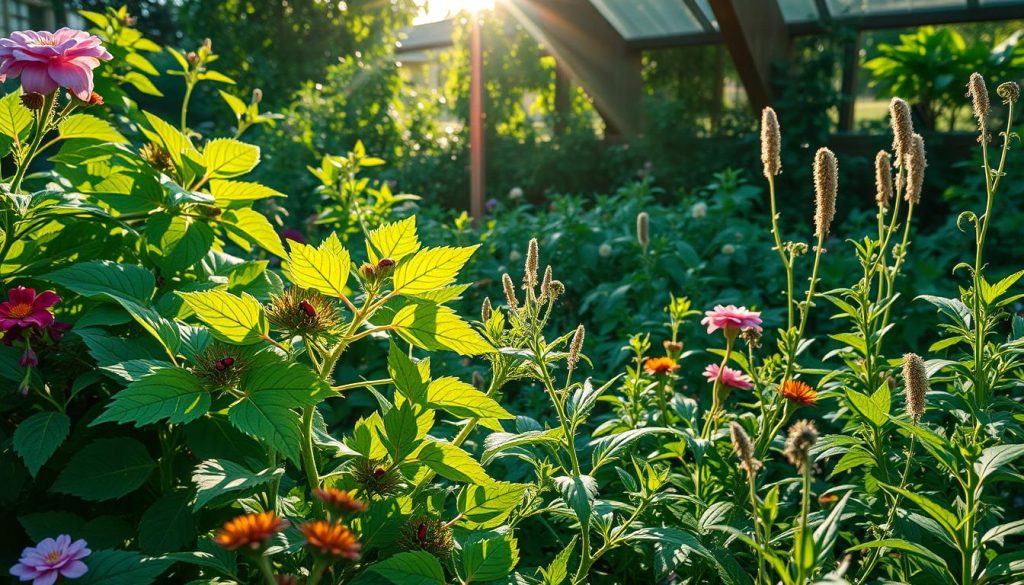
- Organic options: These use natural stuff to fight pests and are better for the planet. Neem oil and diatomaceous earth are good examples.
- Chemical options: These use man-made stuff to fight pests and can work well against big infestations. But, they can hurt good bugs and the environment too.
The best method for me depends on my garden’s needs and the pests I face. Mixing eco-friendly control and resistant plants helps keep my garden balanced and healthy.
| Pest Control Method | Pros | Cons |
|---|---|---|
| Organic | Natural, eco-friendly, safer for beneficial insects | May be less effective in severe infestations |
| Chemical | More effective in severe infestations | Can harm beneficial insects and the environment |
Natural Remedies I Swear By
As a gardener, I’ve found natural insect repellents for plants work well. I’ve tried many methods and want to share my favorites with you. These non-toxic insecticides are good for the environment and easy to make.
Homemade insecticidal soap is a hit with me. It’s made from soap and water. It’s gentle on plants but tough on insects. To make it, mix 1 tablespoon of mild dish soap with 1 quart of water. Spray it on your plants to control insects and protect them.
Homemade Insecticidal Soap Recipe
- 1 tablespoon mild dish soap
- 1 quart water
- Spray bottle
I also love using diatomaceous earth. It’s a powder made from tiny aquatic fossils. It dehydrates insects, killing them. Sprinkle it around your plants, but avoid the leaves and stems.
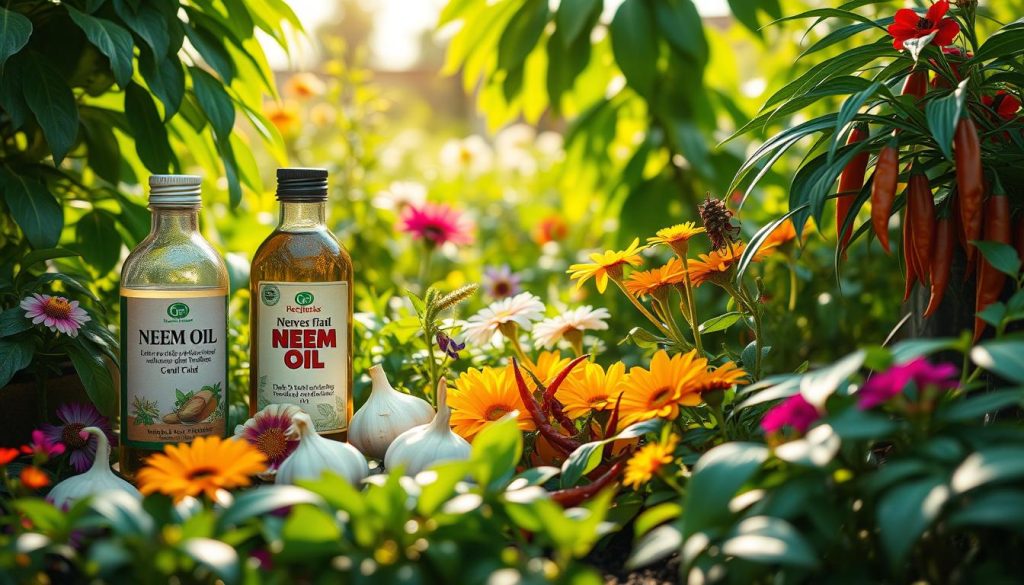
Diatomaceous Earth Benefits
- Natural insecticide
- Non-toxic to humans and pets
- Easy to use
These natural remedies have kept my garden healthy and pest-free. I hope you try them and see the difference. Always choose natural insect repellents and non-toxic insecticides for a safe garden.
| Remedy | Ingredients | Instructions |
|---|---|---|
| Homemade Insecticidal Soap | Mild dish soap, water | Mix 1 tablespoon soap with 1 quart water, spray on plants |
| Diatomaceous Earth | Diatomaceous earth powder | Sprinkle around plants, avoid leaves and stems |
Regular Maintenance for Healthy Plants
To keep my plants healthy, I focus on regular maintenance. This is key for managing garden pests. By using these methods, I’ve seen a big drop in pest problems. This makes it easier to control insect infestations in plants.
Pruning is a big part of my routine. It keeps my plants looking good and removes any damaged parts. These parts can attract pests. So, pruning is a big part of my pest management plan. It stops disease spread and lowers the chance of pests.
How Pruning Keeps Bugs Away
- Removes hiding spots for insects
- Prevents the spread of disease
- Improves air circulation, reducing moisture that attracts pests
The Role of Cleanliness in Pest Prevention
Cleanliness is crucial in stopping pests. I clean my tools often and remove weeds and debris. This stops pests and diseases from spreading. My garden stays healthy and full of life. These habits help me manage pests better.
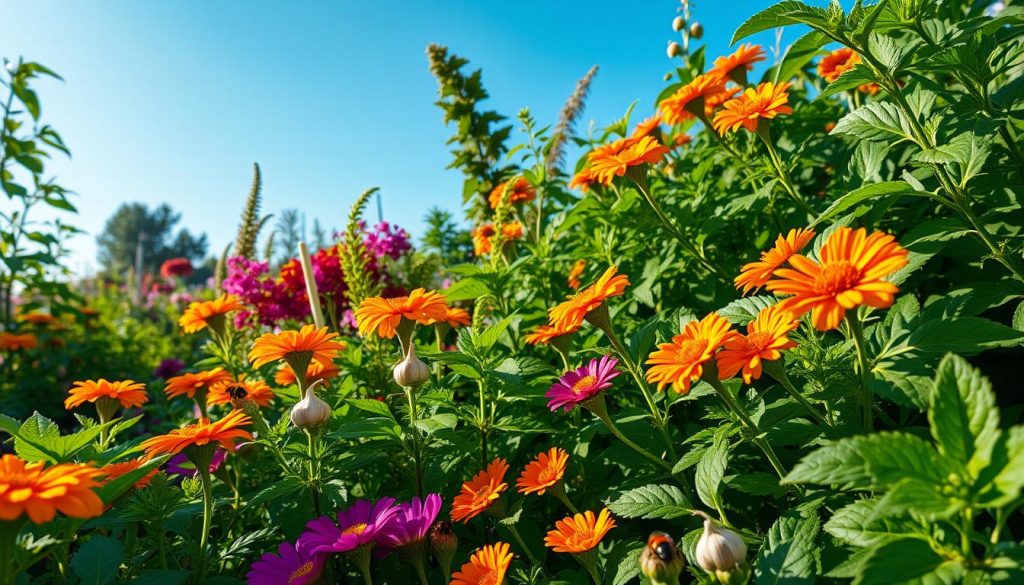
Companion Planting Techniques
I’ve been looking into organic pest control and found companion planting. It’s about growing different plants together to help each other grow and keep pests away. This way, I can make my garden a balanced place, cutting down on chemical pesticides and keeping bugs out.
Companion planting is easy and works well. Some plants, like marigolds and nasturtiums, keep pests away from veggies and flowers. Others, like basil and mint, draw in good bugs that eat pests. Knowing which plants go well together helps me make a garden that fights off pests and needs less pest control.
What are Companion Plants?
Companion plants are species that help each other grow better when planted together. They can offer shade, act as a trap, or keep pests away. Adding them to my garden means I use fewer pesticides and garden more sustainably.
My Favorite Companion Plant Combinations
- Tomatoes and basil: Basil keeps pests like whiteflies and aphids away from tomatoes.
- Marigolds and carrots: Marigolds fight nematodes, which harm carrots.
- Radishes and cucumbers: Radishes keep cucumber beetles away, which spread bacterial wilt.
Using companion planting helps my garden fight off bugs and needs less pest control. It’s good for the plants and helps make a balanced, sustainable garden.
Utilizing Physical Barriers
Physical barriers are a great way to keep insects out of your garden. They are simple and good for the environment. Row covers and garden netting help protect your plants from pests.
Row Covers
Row covers are a fantastic tool for keeping insects away. They are light, let plants breathe, and block bugs. I put them over my plants when insects are most active.
Garden Netting
Garden netting is another good choice for insect control. It’s a mesh that lets plants get sunlight and water but keeps bugs out. I use it on plants that often get infested.
Some benefits of using physical barriers include:
- Easy to install and remove
- Reusable and durable
- Effective against a wide range of insects
- Chemical-free and eco-friendly
Physical barriers help my plants grow safely and healthily. They also cut down on the need for harmful chemicals. This keeps my garden balanced and eco-friendly.
Encouraging Beneficial Insects
To keep your garden healthy, it’s key to attract beneficial insects. These, like ladybugs and pollinators, help control pests and boost plant growth. Using natural repellents and non-toxic sprays can draw these helpful bugs to your garden.
Planting a variety of flowers and herbs can attract these insects. Ladybugs love marigolds and calendula, while pollinators go for sunflowers and lavender. Adding these plants makes your garden a welcoming spot for beneficial insects.
The Role of Ladybugs in My Garden
Ladybugs eat aphids, whiteflies, and other pests that harm plants. They help reduce the need for harmful sprays, making your garden balanced. Ladybugs are also drawn to nectar-rich flowers, making them easy to attract.
Attracting Pollinators to Boost Defense
Pollinators, like bees and butterflies, are vital for plant reproduction and pest control. Planting a mix of flowers that attract them makes your garden strong and diverse. Some good plants for pollinators include:
- Sunflowers
- Lavender
- Coneflowers
- Black-eyed Susans
By using natural repellents and attracting beneficial insects, you can have a healthy garden. This method controls pests, promotes plant growth, and cuts down on chemical use.
Monitoring and Early Detection
To keep your garden healthy, it’s important to watch your plants closely. Look for signs like holes in leaves or white patches on stems. This way, you can catch problems early.
By checking your plants often, you can stop pests from spreading. This helps keep your garden balanced and healthy. Some things to watch for include:
- Unusual leaf damage or discoloration
- Presence of eggs or larvae on plant surfaces
- White, cottony patches indicating fungal growth
It’s also good to keep a record of what you see. This helps you see patterns and what works best for your garden. By monitoring and recording, you can keep your garden pest-free and thriving.
Good garden pest management is about watching, recording, and acting. Stay alert and adjust your plans as needed. This way, you can protect your plants and enjoy a great harvest.
| Monitoring Frequency | Plant Type | Potential Pests |
|---|---|---|
| Daily | Leafy Greens | Aphids, Whiteflies |
| Weekly | Flowering Plants | Beetles, Caterpillars |
| Monthly | Fruit Trees | Scale, Mites |
Seasonal Strategies for Pest Control
To keep your garden healthy, change how you fight pests with the seasons. Insects act differently with the weather, so using eco-friendly methods is key. Knowing these changes helps you stop bugs before they start.
Adjusting Your Approach
In spring and summer, insects buzz around more. It’s important to watch for bugs in your garden. Here are some ways to control pests without harming the environment:
- Check your plants often for signs of pests
- Try natural solutions like neem oil and diatomaceous earth
- Help good bugs like ladybugs and lacewings
Weather Changes and Insect Activity
Weather affects insects, so being ready is crucial. For example, dry and warm weather brings more aphids and whiteflies. Cool, wet weather helps fungi grow. Knowing this lets you adjust your pest control to keep your garden safe.
| Season | Insect Activity | Eco-Friendly Control Methods |
|---|---|---|
| Spring | Increased activity of aphids and whiteflies | Inspect plants regularly, use neem oil and diatomaceous earth |
| Summer | High activity of beetles and caterpillars | Encourage beneficial insects, use physical barriers like row covers |
| Fall | Decreased activity of most insects | Continue to inspect plants, use natural remedies as needed |
| Winter | Low activity of most insects | Plan for the upcoming season, prepare natural remedies and beneficial insects |
Creating a Balanced Ecosystem in My Garden
Keeping a garden healthy is more than fighting pests. It’s about making a balanced ecosystem that supports life. By using organic methods for pest control and garden pest management, I’ve kept pests away while boosting biodiversity.
The Benefits of Biodiversity
A diverse garden is strong. Adding native plants and beneficial insects has cut down on pests. Ladybugs control aphids, and pollinators make my plants grow well.
Tips for Maintaining a Healthy Garden Habitat
To keep my garden balanced, I provide food and shelter all year. I avoid harsh chemicals and use natural methods. Companion planting, barriers, and watching for pests help me keep my garden in harmony with nature.

